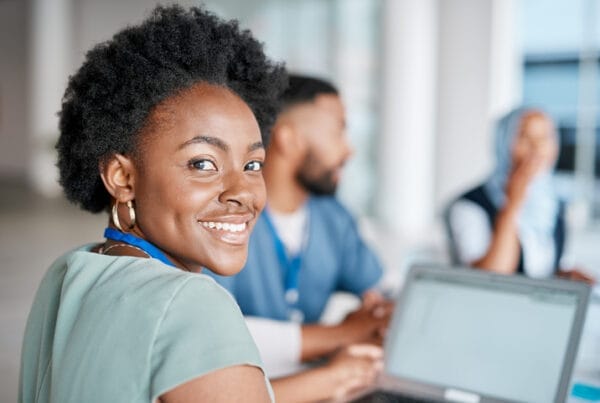The COVID-19 pandemic affected healthcare recruiting in a number of ways. With many RNs and LPNs leaving the workforce by choice or necessity, healthcare employers were forced to reconsider how they recruited new employees.
One of the major responses to the pandemic was an expansion of digital recruitment. At its best, digital recruitment can help employers fill high-volume roles quickly and efficiently. If recent hiring trends are any indication, it looks like long-term care will be adopting digital recruitment for good. To help your facility make the most of these developments, we’ll review three of the top trends in recruiting technology and isolate takeaways for long-term care.
1. Healthcare Recruiters Are Screening and Interviewing Online
Just like much of healthcare, long-term care facilities are facing serious staffing shortages—yet these facilities have received relatively little federal acknowledgment or support. Because of this, HR departments are under pressure to develop their own strategies to handle the nursing shortage. One of these strategies is to speed up the hiring process by moving it online.
Online interviewing is a widespread strategy that is here to stay—and is just as effective as in-person interviewing. In fact, the Society for Human Resource Management found that 70% of talent professionals predicted virtual hiring will stay in place as standard practice—and that certainly applies to long-term care, where speedy recruitment processes give organizations a better chance of onboarding top candidates.
What Long-Term Care Providers Should Do
To stay competitive in the post-pandemic world, hold onto your virtual hiring process. Take a look at your process from beginning to end and consider places where you could increase efficiency.
Consider holding a brainstorming session on online interviewing, including everyone involved with hiring. Ask what they like and struggle with during online interviews. Use this information to provide support or modify your process for long-term success.
2. Healthcare Employees Are Onboarding Virtually
Virtual onboarding is a natural extension to a more digital healthcare recruiting process. When used well, it can give you better security, preparation, and oversight. Candidates themselves are divided about this trend, with 41% preferring in-person onboarding, and 35% preferring onboarding that takes place online.
A combination of online and offline onboarding methods is likely to appeal to the largest group of caregivers. Using at least some digital onboarding can amount to more personalized in-person training time. This, in turn, can increase staff satisfaction and productivity.
What Long-Term Care Providers Should Do
Strong onboarding is vital. Poor communication is one of the top reasons caregivers leave their organizations, so you can get off to a good start by showing your commitment to clear expression of expectations, values, and policies.
Pre-qualify candidates during the hiring process by requesting license verification right away. Doing this will both help you find the best candidates and free up in-person onboarding time to focus on more interesting things. Keep track of paperwork with a strong applicant tracking system to save time onboarding in the long run.
3. Employers and Candidates Are Connecting Digitally
Digital connections between recruiters and candidates were already on the rise, but the pandemic increased this trend even further. Social media recruiting is also growing in popularity, and job seekers are coming to expect that they can turn to online tools to decide if a role with a given company might be a good fit.
In Apploi’s report on the state of healthcare recruiting, we found that digital job posts surged in 2020 and 2021. More jobs than ever are being posted online, and as a result, we’re seeing greater competition to craft compelling job descriptions. Recruiters are making the most of this trend by investing in texting software that lets them stay in touch with busy applicants, and introducing mobile-first applications.
What Long-Term Care Providers Should Do
In this age of digital recruiting, use every tool you have. Take your time with job posts. Make sure they’re polished, that they use inclusive language, and that they’re optimized for social media. Once you’re happy with your job posts, share them widely. Track performance to see where your long-term care applicants are actually coming from, and tailor your job posts to these sources. (Not sure how to do this? Apploi can help.)
Polish your brand image. Think about your organization from a marketing perspective. How would your web pages and social media look to a jobseeker not familiar with your organization? You might want to enlist help from someone outside your workplace. Ask for their impressions and make adjustments based on their reactions. A strong brand image makes it easier for candidates to say yes to an offer and makes it more likely that they’ll seek you out.
Conclusion
Interested in learning more about how you can recruit, hire, and onboard healthcare staff quickly? Contact us today for a free demo of our end-to-end solution.






